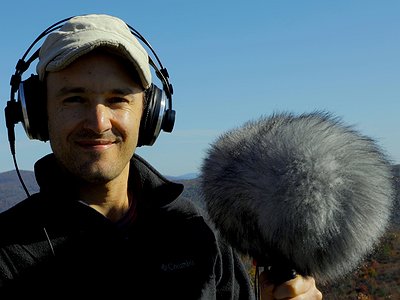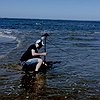Part 2
How do you make use of technology? In terms of the feedback mechanism between technology and creativity, what do humans excel at, what do machines excel at?
Technology for me is mostly a tool for understanding the complexity of the environmental sounds that fascinate me. Microphones allow me to hear with more detail, which I often describe through the analogy of a microscope. Just as the microscope allows us to see the detail that our eyes can’t reach, the microphone allows us to hear that which our ears can’t reach. Sound analysis software, mainly in the spectral domain, allows me to understand sound more accurately and also to compute patterns and averages much faster than if I used only my ears. In this sense, the computer helps me to morph oftentimes chaotic information into intelligible, beautiful information.
For example, it helps me to extract a chord with the most prominent frequencies of the noise of a braking wave in the ocean out of thousands of frequencies of a relatively similar amplitude. In this sense, the technology not only saves me hundreds of hours of pre-composition for my environmental sound-derived work, but it also offers inspiring pattern organizations, visualizations, etc., that lead me to ideas that I would otherwise not have.
This is especially true for pieces like Geysir and Waves Break Aural Shores, in which statistical analysis as well as different resolution settings for spectral analysis are the basis of the compositions.
Collaborations can take on many forms. What role do they play in your approach and what are your preferred ways of engaging with other creatives, including the artists performing your work?
My approach necessitates collaboration due to its interdisciplinary nature and its instrumental experimentation. Sound worlds that I explore such as underwater Arctic cetacean sounds, the relation between forest cover and climate, and statistical data of geological noise have led me to find very inspiring people in those fields (Marine Biology, Environmental Sciences, Data Science). Their information have given my music a scientific quality that I find essential.
On the other hand, since many of the sounds that I work with are translations of natural sound models (bearded from the Arctic, crickets, cicadas, geysers, etc.), I collaborate with the performers of my music by exploring the sonic features of their instruments in relation to the sound models that they are translating. Many times, such collaborations derive in an expansion of my notation concepts and the performers’ instrumental vocabularies.
How is writing the music and having it performed live connected? What do you achieve and draw from each experience personally? How do you see the relationship between improvisation and composition in this regard?
I compare the connection of composing and live performance with cooking. The detailed attention to each sound, material, gesture, place in time, etc., is analogous to the attention to each color, size, texture, amounts, etc., of the discrete ingredients of a recipe prior to blending and cooking them together. There is an enormous aesthetic value in every discrete component on its own. Once the materials are blended together, orchestrated, and performed, they become a single entity (especially in most of my music, which tends to be quite textural), quite different from its parts, but with traces of all of them, just like the finished dish.
Another very important aspect of the live performance is that the piece becomes autonomous. It is no longer my intentions that shape it, but those of the performers and, most importantly, the listeners.
I will borrow Roscoe Mitchell’s thought regarding improvisation and composition: improvisation is composition in real time. For me, the only difference is the time allowed for ideas to take place.
Time is a variable only seldomly discussed within the context of contemporary composition. Can you tell me a bit about your perspective on time in relation to a composition and what role it plays in your work?
Composing with natural processes and sound models has led me to engage with time in two ways: cyclically and linearly. These “modes” of time exist in a duality in most of my environmental sound-oriented composition. Many processes in nature are cyclical, and some of them, especially geological ones, may seem static to human perception. While sometimes I am drawn to the aesthetics of stasis, my compositional upbringing draws me to introduce a sense of perceivable linearity in time.
This notion of linear time may result from different ways to engage with material. For example, in “Geysir”, for seven pianists, the original sound model of the geyser is generally static, with the exception of a few intensity increases throughout 10 minutes of recording. For the original version of the piece, each piano played the loudest pitch content of its assigned frequency band for the entire piece. True to the original geyser recording, this version presented a time mode of stasis. A next version of the piece consisted of alternating different pianos at different registers, allowing a more detailed listening of each of the frequency regions of the geyser.
The contrast of registers produce a linear time perception as opposed to a static one where all registers were sounding at all times, like in nature.
How do you see the relationship between the 'sound' aspects of music and the 'composition' aspects? How do you work with sound and timbre to meet certain production ideas and in which way can certain sounds already take on compositional qualities?
Composition and sound aspects are one and the same in my work. I learn from environmental sounds fascinating aspects of timbre, such as the harmonic qualities of rustling leaves, of a stream, of mammals … My explorations of those timbres, those sounds, are the foundations of several compositional parameters, such as form and even motivic material.
Our sense of hearing shares intriguing connections to other senses. From your experience, what are some of the most inspiring overlaps between different senses - and what do they tell us about the way our senses work? What happens to sound at its outermost borders?
Lately, I have been thinking different categories of sound based on Lasse Thoresen’s adaptation of Pierre Shaeffer’s typomorphology. From that perspective, sound is broadly categorized as ‘pitched’ and ‘complex’ (noise), with various ramifications. I have been fascinated by how this finds a perfect parallel with visual elements in nature as well as visual art, with a particular interest in visual noise. For example, Yan Pei-Ming’s “A Burial in Shanghai” three panels in large format, contains different qualities of noise in various tones of gray. Canopies I also perceive as noise, with the complex patterns of interwoven leaves and shades of green.
I also find an interesting parallel of this ‘pitched’ and ‘complex’ categorization in gastronomy. I may sometimes cook something ‘pitched’, with a very defined quality of ingredient or group of ingredients, paralleling a harmonic sound, so to speak, in which each ingredient is a harmonic of a fundamental. Noisy, inharmonic recipes, in which various flavors are dissolved in a complex oneness, are absolutely more difficult, and quite entertaining.
Art can be a purpose in its own right, but it can also directly feed back into everyday life, take on a social and political role and lead to more engagement. Can you describe your approach to art and being an artist?
Throughout the past five years, pivotal in the global awareness of climate change, carbon footprint, and our impact on the environment, my music has naturally adopted a somewhat environmentalist tone. Sound models that I have analyzed and translated into instrumental music, such as Arctic bearded seals, or data of tides, naturally lead to reflections on climate as a by-product.
Additionally, the compatibility of my work with institutions that fund environmental resilience projects has resulted in commissions specifically designed to increase social awareness of climate change. I love nature and I am an advocate of a greener world, so this direction that my work has taken has strengthened its purpose and meaning.
It is remarkable, in a way, that we have arrived in the 21st century with the basic concept of music still intact. Do you have a vision of music, an idea of what music could be beyond its current form?
I have a sort of stoic vision of music, one in which the most important and, perhaps, sole aspect is the listening, the active and constant listening to anything and everything. My environmental sound-oriented work over the years has led me to hear everything as, like Cage once said, organized sound, which is my definition of music. I sometimes find that the most gratifying music that I hear is not “music”, but sounds that were not originated as music.
I sometimes wonder how the world would be if people could sit in a room or a space (interior or exterior) and quietly just listen to the sounds that surround them, feeling connected as if they were in a concert. Of course this vision of music as an established practice is highly unlikely, but I like to imagine it as a fictional situation, either literary or cinematographically.






